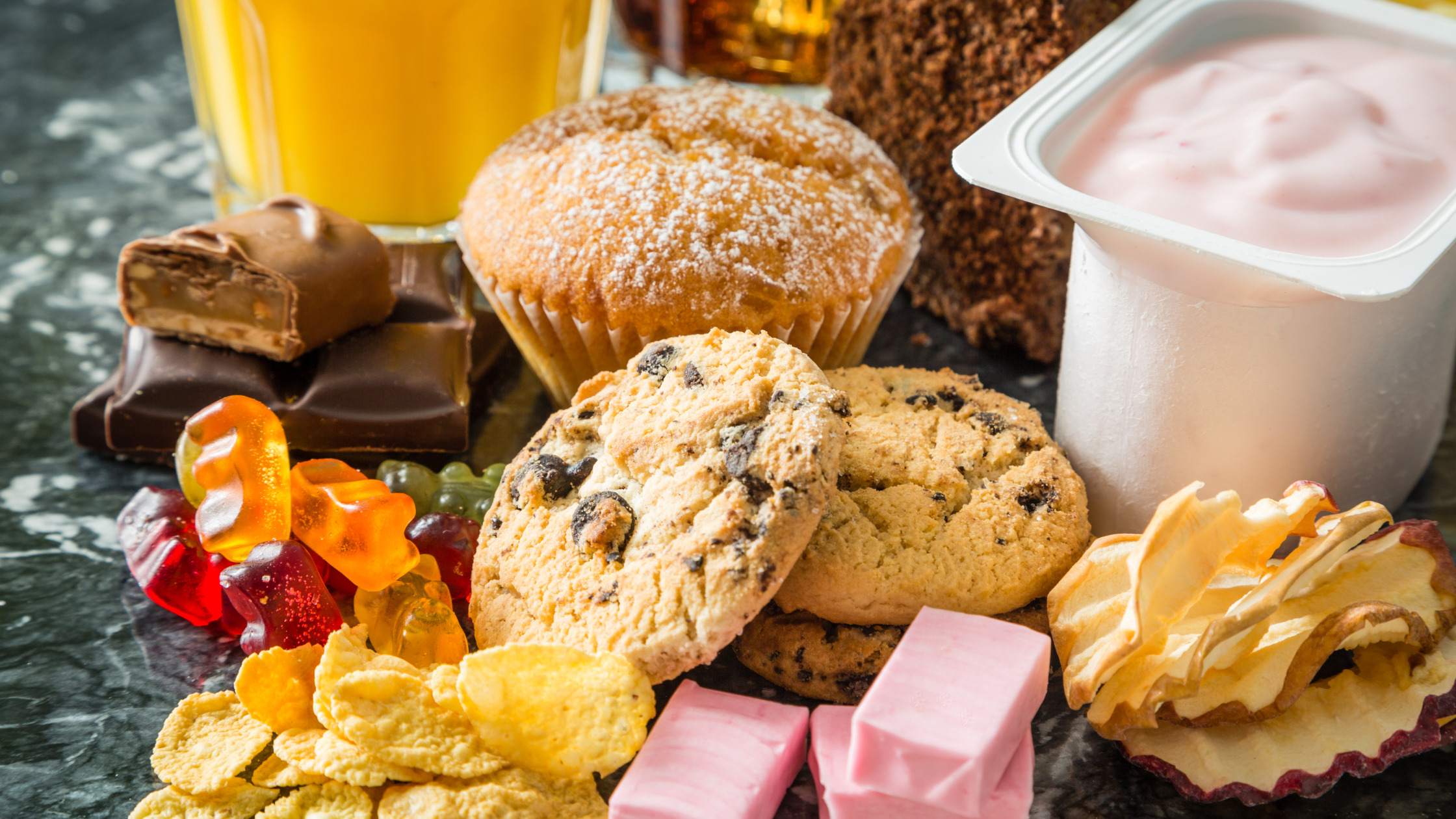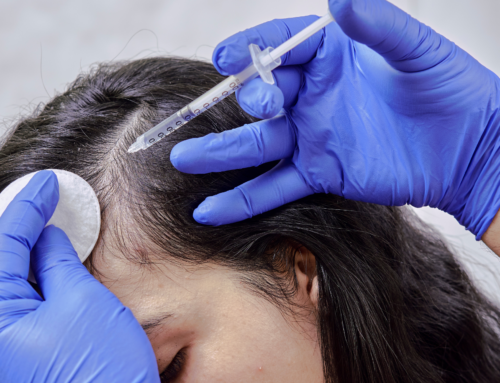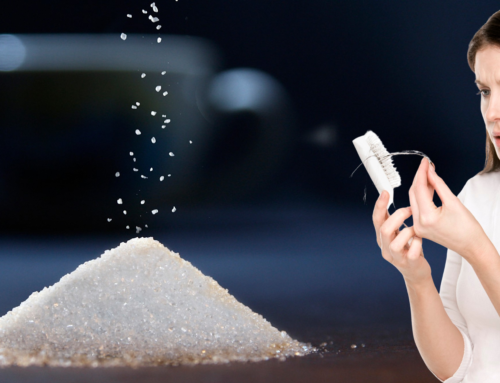If you’re noticing hair loss these days, you aren’t alone. Many people are in the same boat.
One of the key causes of hair loss is systemic inflammation, which can be due to your diet.
A low-inflammation diet is designed to support your body in healing in three ways:
1. It prevents mycotoxins from accumulating in your body by limiting your exposure to potentially contaminated food sources.
2. It focuses on restoring nutrient deficiencies and imbalances.
3. It boosts your body’s immune function and ability to repair itself by minimizing inflammatory foods that suppress your immune system.
What Foods Should I Avoid on the Low-Inflammation Diet?
When adhering to a low-inflammation diet, it’s essential to steer clear of foods rich in sugars and additives, as they can fuel fungal growth and potentially worsen your symptoms.
Additionally, it’s advisable to avoid foods known for being susceptible to mold contamination.
When following the low-inflammation diet, you should avoid the following:
Sugar-Laden Foods
Sugars serve as one of the main sources of fuel for candida or mold. Sugar, in particular, can be deceptive as it can be disguised under various names and may be concealed in unexpected places – including foods typically perceived as “healthy.”
You should avoid:
- Table sugar
- Glucose
- Lactose
- Fructose
- Mannitol
- Sorbitol
- Honey
- Maple syrup
- Molasses
- Candy
- Baked goods
Certain fruits also have a notoriously high sugar content and should be avoided when detoxing, including:
- Pineapples
- Mangoes
- Bananas
- Melons
- Oranges
- Grapes
- Dried fruits and fruit juices
Although sugar is often the primary dietary factor contributing to fungal growth, fast-absorbing carbohydrates and artificial additives can also foster mold growth. This leads us to the next category of foods to steer clear of.
Packaged and Processed Foods
Processed and pre-packaged foods almost always contain sugars, simple carbs, and/or additives that will fuel fungal growth in the body.
You’ll want to stay away from the following foods:
- Pre-packaged meals: Ready-made meals, breakfast cereals, frozen foods
- Canned foods: Baked beans, soups, ready-made sauces
- Processed drinks: Soft drinks, fruit juices, flavored water, energy drinks
- Bottled condiments: Vinegar, mayonnaise, pickles, soy sauce, mustard, relish
Get in the habit of reading the ingredient list of any product before you buy it. In general, if a product has more than five ingredients or is full of things you don’t recognize – it’s best to avoid it while on the low-mold diet.
Mold and Yeast Containing Foods
Some examples are:
- Cheese and sour milk products: Buttermilk, sour cream, cream cheese, aged cheese
- Nuts: Peanuts, cashews, walnuts, Brazil nuts
- Dried fruit: Raisins, apricots, prunes, figs, dates, etc.
- Grains: Wheat, rice, oats
- Packaged and smoked meats: Sausages, hot dogs, corned beef, pastrami, smoked fish, ham, bacon.
- Edible fungi: Mushrooms, truffles
- Alcoholic beverages: Beer, wine, cider, liqueur, whiskey, gin, rum, tequila, etc.
- Fermented foods should be avoided in those with histamine intolerance
While this list may seem restrictive, the good news is, there are still plenty of delicious foods allowed on the low-inflammation diet.
Foods to Eat in Moderation:
Moderate inclusion of the following foods is acceptable in a low-inflammation diet:
- Gluten-free grains: Brown rice, quinoa, buckwheat, millet, teff, certified gluten-free oats
- Starchy vegetables and legumes: Sweet corn, potatoes, beans, peas, lentils, sweet potatoes, squashes, turnips, parsnips
- Low-sugar fruits: Berries, apples, pears, peaches, avocados
While it’s fine to include these foods occasionally, aim to center the majority of your meals around the foods in the next category.
Foods to Eat Freely:
When following a low-mold diet, the quality of your food selections is paramount. Choose organic, pasture-raised, and grass-fed meats. Opt for wild-caught fish and seafood. Whenever available, select organic produce to maintain high quality and reduce mold exposure.
Foods to eat in as much as you’d like on a low-inflammation diet:
- Poultry (pasture-raised, organic only): Chicken, eggs, turkey, quail, pheasant
- Fish (wild-caught only): Salmon, tuna, anchovy, sardines, flounder, catfish, caviar
- Other meats (grass-fed only): Beef, goat, lamb, buffalo, wild game, rabbit
- Raw nuts and seeds: Sunflower seeds, pumpkin seeds, flax seeds, chia seeds, almonds, pecans, sesame seeds
- Leafy greens: Romaine, kale, collard greens, spinach, turnip greens, green and red cabbage
- Root vegetables: Carrots, onions, radishes, garlic
- Gourd vegetables: pumpkins, squash, eggplants, zucchini
- Other vegetables: Cucumbers, brussel sprouts, asparagus, artichokes, broccoli, cauliflower, bell peppers
- Spices: Pure vanilla, cinnamon, cayenne pepper, pink Himalayan salt, wasabi, horseradish
- Herbs: Parsley, cilantro, basil, chives, mint, oregano, rosemary, sage, thyme, tarragon, etc.
- Healthy fats: Extra virgin olive oil, coconut oil, coconut milk, ghee, organic butter
- Beverages: Filtered water, mineral water, non-fruity herbal teas, fresh vegetable juice
Building your meals around these nutrient-dense, whole foods will equip your body with the nutrients it needs to properly heal and detox.
Mold and Cravings
- The simpler the carbs, the better. But mold would prefer you go straight for the sugar.
- For people on long-term steroid medication, mold in the gut becomes a dense biofilm.
- This biofilm hosts the gut fungus candida – which steals the nutrients for itself, leaving our intestine deprived.
- Mold sufferers crave these carbs and sugars because the candida is stealing it.
Getting Rid of Moldy Foods
If you’ve been experiencing symptoms of toxic mold exposure, you’re likely eager to find strategies to alleviate your discomfort. However, before you begin preparing a meal from ingredients in your fridge or pantry, it’s crucial to carefully assess the food you intend to use.
Are There Any Other Ways to Enhance Mold Detoxification?
When you’re fighting mold illness, the symptoms can feel overwhelming and your recovery time may or may not be quick. On top of following the low-mold diet, you can enhance your detoxification and significantly cut your recovery time down by using the following strategies.
Use Detox Binders:
Detox binders are designed to “bind” to toxins in your body so they can be safely eliminated.
The most effective detox binders that we recommend are:
- Activated Charcoal
- Upgraded Coconut Charcoal
- Binders
- G.I. Detox
Supplements that aid in facilitating detoxification:
- Glutathione
- Milk Thistle Extract
- R-Lipoic Acid
- Quercetin
- N-Acetylcysteine
Ways to Prevent Mould From Growing in Your House
To prevent the growth of mold on surfaces, it’s crucial to mitigate moisture accumulation, especially within the 24-48 hour window when mold can flourish. Here are some effective strategies:
- Avoid leaving wet towels or swimwear on wooden surfaces such as chairs, tables, or window sills.
- Promptly clean up spills on wooden surfaces to prevent moisture buildup.
- Utilize the kitchen fan while cooking to reduce humidity levels.
- When taking hot showers, activate the exhaust fan to remove steam and moisture from the bathroom.
- Employ a dehumidifier in lower levels of your home and regularly monitor humidity levels.
- Refrain from storing cupboard boxes directly on the floor in storage rooms.
- Elevate storage units on stilts to create airflow underneath and deter moisture accumulation.
- Opt for construction materials like bricks over wood to minimize mold-friendly environments.
- Install an air filter and adhere to regular filter changes to maintain clean indoor air quality.
- Dust your home frequently, as accumulated dust can serve as a food source for mold growth.
By implementing these preventative measures, you can effectively reduce the risk of mold formation and maintain a healthy indoor environment.
How Long Does It Take to Get Mold Out of Your System?
The answer to that question is – it depends. Exactly how long it’ll take you to recover from mold illness depends on several factors:
Length of Exposure:
This is the greatest factor in determining how long it will take for mold to get out of your system. If you’ve been exposed for long periods, such as years, you’re likely to have mold buildup in your body.
Typically, the longer the exposure, the longer the recovery time. This is why removing any mold exposure sources is the first step in recovering from mold illness. If you fail to remove the sources of mold exposure – whether environmental or through the foods you eat – you may never be able to fully heal.
Type of Exposure:
Approximately 90% of molds are generally nonpoisonous and pose little risk to the majority of the population. However, for individuals with fungal allergies, even these seemingly benign molds can provoke significant health issues.
Those with fungal allergies who are exposed to the 10% of molds that are poisonous may experience prolonged recovery periods. This is primarily due to the presence of toxic metabolites called mycotoxins, which are produced by poisonous molds. Mycotoxins have the potential to accumulate in the body and cause damage over time.
If you suspect that inflammation or mold exposure is affecting your hair and well-being, please don’t hesitate to call us at 941-909-7701 to schedule your hair loss treatment with Cellustrious®. Let’s work together to bring out the best in your hair.






Leave A Comment